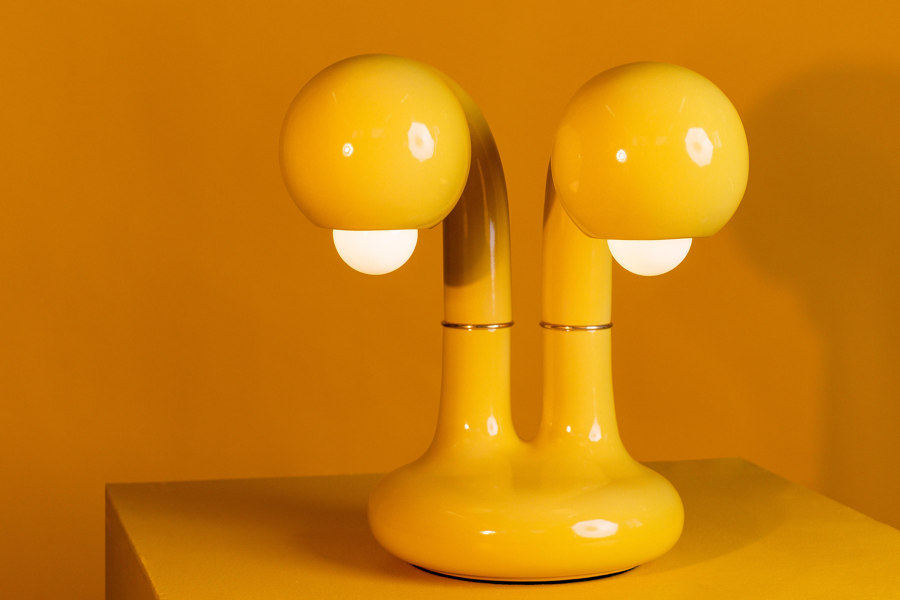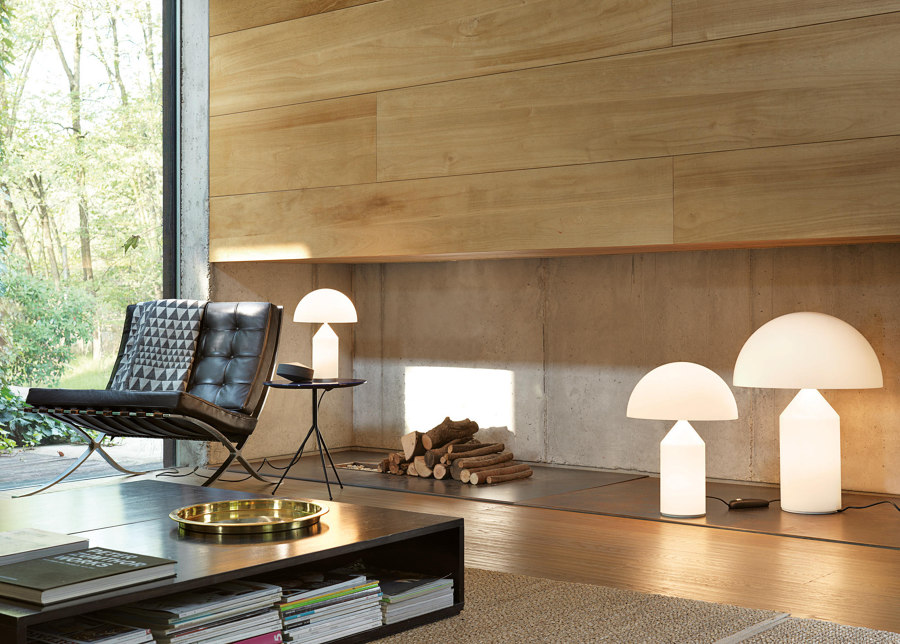Space-age product design of the 20th century and beyond
Text von James Wormald
27.09.23
In the midst of a contemporary space race, we look into humanity’s obsession with space and the products – both past and present – inspired by the beauty we find when we look up.
Vico Magistretti’s Atollo lamp for Oluce: combining the geometric shapes of the universe and spaceflight

Vico Magistretti’s Atollo lamp for Oluce: combining the geometric shapes of the universe and spaceflight
×Ever since humans first looked up towards the heavens, we’ve wondered what is up there. From 1923 when Edwin Hubble first discovered galaxies beyond our own, our hunger and obsession for knowledge of the cosmos has grown almost as quickly as the universe itself. As our technology advanced throughout the 20th century, we realised that ‘space’ is, in fact, filled with a huge array of ever more colourful galaxies, gasses and stars. And the world’s leading product designers were taking note.
Artemide’s Eclisse lamp, designed by Vico Magistretti in 1965 (top, middle) and Jasper Morrison’s Superloon light from Flos at the Cosmos: Design from Here and Beyond exhibition at Mudac (bottom)

Artemide’s Eclisse lamp, designed by Vico Magistretti in 1965 (top, middle) and Jasper Morrison’s Superloon light from Flos at the Cosmos: Design from Here and Beyond exhibition at Mudac (bottom)
×The space race and its influence on design
After the USSR surprised the rest of the world by successfully sending the first object into orbit (Sputnik 1) in 1957, not to be outdone, US President John F. Kennedy famously chose ‘to go to the moon’ within the decade. The race to explore space had begun and, in doing so, offered fuel to the fire of our obsession.
‘Since the dawn of humankind, we’ve found wonder and inspiration in celestial bodies and the physical laws that structure them’
‘Since the dawn of humankind, the visual arts, architecture and other spheres have found wonder and inspiration in celestial bodies and in the physical laws that structure them. Design is no exception’ explains Marie Pok, curator of the Cosmos: Design from Here and Beyond exhibition at the Museum of Contemporary Design and Applied Arts in Lausanne, Switzerland.
In 1965, for example, a year when the USSR and USA’s competitive space programmes traded exploration records and press releases, Vico Magistretti created the Eclisse lamp, using the simple arrangement of a solar eclipse to control the intensity of light.
Oluce’s Atollo lamp, made up of a cylinder, a cone and a hemisphere, is available in black and white glass (top), and satin bronze or satin gold aluminium (bottom)

Oluce’s Atollo lamp, made up of a cylinder, a cone and a hemisphere, is available in black and white glass (top), and satin bronze or satin gold aluminium (bottom)
×Storytelling with rocket shapes in product design
Once the ‘giant leap for mankind’ had been taken, the competitive element of the space race was all but over. And yet in another, more influential way, it had only just begun. From the dual targets of getting into space and onto the moon, humanity adjusted its focus on staying there. In 1972, NASA began the Space Shuttle programme to develop a rocket that was powerful enough to escape Earth, while being sturdy enough to not only make it back but also go again.
‘The modern image of the cosmos is embodied in design projects that lead us far beyond its scientific roots and reflect its mysteries and beauty’
Magistretti’s Atollo lamp for Oluce, for example, created in 1977, tells the story of a rocket on its way to a spherical body, possibly the moon or a more distant planet. ‘The geometric shapes that compose the lamp – cylinder, cone and hemisphere,’ as the lamp’s manufacturer Oluce explains, ‘have resulted in a product that is decorative and essential.’ And since its release, Atollo has continued its journey to become an icon of design, breaking from the historical period and fashions of the moment.
Vitra’s Panton chair is one of the first and foremost examples of curved forms in space-age furniture design and the Origin table from Babled depicts the gravitational forces surrounding a black hole

Vitra’s Panton chair is one of the first and foremost examples of curved forms in space-age furniture design and the Origin table from Babled depicts the gravitational forces surrounding a black hole
×Astrophysics and the laws of the universe in design
It isn’t just the physical forms we use to get to space or the visual souvenirs we bring back that inspire our creatives down here on Earth, of course. But also the knowledge and understanding we have about the world around us, too. ‘The modern image of the cosmos is embodied in design projects that lead us far beyond its scientific roots and reflect its mysteries and beauty’ enthuses Marie Pok.
Whether from the projected orbit of celestial bodies, Earth’s own magnetic field or the mathematical beauty of the gravitational forces surrounding a black hole, space is full of curves. Although the curving form of the iconic Panton chair, for example, was enabled by advancements in material and manufacturing technology throughout the second half of the 20th century, the popularity of the chair owes a gratitude to our continued obsession with the curves of space-age interiors.
With a spread-out ‘foot’ at the base and large, spherical and sometimes multiple heads with a single bulb depicting an eye, Jonathan Entler’s Entler table lamps are human enough to look alien

With a spread-out ‘foot’ at the base and large, spherical and sometimes multiple heads with a single bulb depicting an eye, Jonathan Entler’s Entler table lamps are human enough to look alien
×Alien life-forms represented in product design
Once able to regularly travel to space, humanity’s focus turned towards how long we were able to stay there – learning to live away from Earth for longer periods on the International Space Station, and ultimately, how far out we could go. Our attention down here on Earth, meanwhile, jumped forward to what we might find while there.
This balanced design hinting at movement makes the alien-shaped object seem so alive
Strangely, when designers combine the simplicity of a curved shape with at least one human-like ability – such as to walk or to see, for example, it's precisely this human-like ability that makes the object seem so alien. Take Philippe Starck’s iconic Juicy Salif, for example. The egg-shaped juicer sits atop three pointed legs, seemingly poised to walk across the worktop, and it’s this balanced design hinting at movement that makes the alien-shaped object seem so alive.
Other contemporary space-inspired products include Please Wait to be Seated’s Planet lamp with moveable celestial bodies (top, middle) and Flos’s 360-degree adjustable Superloon floor light (bottom)

Other contemporary space-inspired products include Please Wait to be Seated’s Planet lamp with moveable celestial bodies (top, middle) and Flos’s 360-degree adjustable Superloon floor light (bottom)
×The contemporary space race and re-emergence of space-age design
Although many can argue that it never went away, the boom in the commercial interest in space flight for tourism, material mining and even our urgency to become a ‘multi-planet species’, is rocketing space-age design back into contemporary designers’ works.
The Superloon floor lamp designed by Jasper Morrison, for example, rotates a large light-giving object 360 degrees, emitting different intensities of light high in a room, the Origin table from Babled ignores the flatness usually asked of a tabletop and imitates gravitational forces by sinking part of its surface in the centre, Please Wait to be Seated’s Planet lamp moves discs of varying material and colour on a wall like a two-dimensional orrery and the Entler Table lights from Jonathan Entler are a series of alien-like lightforms.
© Architonic
Head to the Architonic Magazine for more insights on the latest products, trends and practices in architecture and design.

































